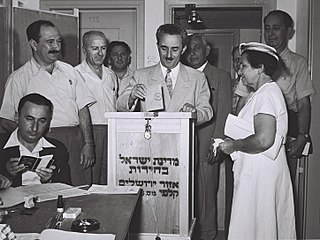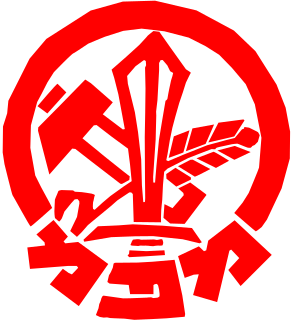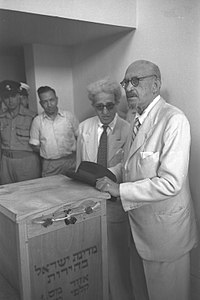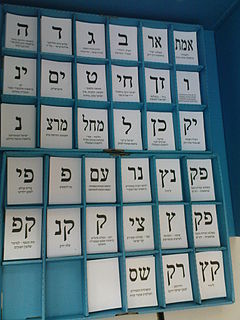Mapai was a centre-left political party in Israel, and was the dominant force in Israeli politics until its merger into the modern-day Israeli Labor Party in 1968. During Mapai's time in office, a wide range of progressive reforms were carried out, as characterised by the establishment of a welfare state, providing minimum income, security, and free access to housing subsidies and health and social services.

Elections for the third Knesset were held in Israel on 26 July 1955. Voter turnout was 82.8%.
Hapoel HaMizrachi was a political party and settlement movement in Israel and is one of the predecessors of the National Religious Party, which later became the modern-day Jewish Home Party.
Elections for the fourth Knesset were held in Israel on 3 November 1959. Voter turnout was 81.5%.
Mizrachi was a political party in Israel and is one of the ancestors of the modern-day Jewish Home Party.
Elections for the fifth Knesset were held in Israel on 15 August 1961. Voter turnout was 81.6%.
The Faction independent of Ahdut HaAvoda was a short-lived political party in Israel.
Elections for the sixth Knesset were held in Israel on 2 November 1965. Voter turnout was 85.9%.

The fourth government of Israel was formed by David Ben-Gurion during the second Knesset on 24 December 1952. Ben-Gurion dropped the ultra-orthodox parties Agudat Yisrael and Poalei Agudat Yisrael from his coalition and replaced them with the General Zionists and the Progressive Party, who formed the government together with Mapai, Mizrachi, Hapoel HaMizrachi, the Democratic List for Israeli Arabs, Progress and Work and Agriculture and Development.

The fifth government of Israel was formed by Moshe Sharett during the second Knesset on 26 January 1954, and was the first government not led by David Ben-Gurion. Sharett kept the same coalition partners as during the fourth government, i.e. Mapai, the General Zionists, the Progressive Party, Mizrachi, Hapoel HaMizrachi, the Democratic List for Israeli Arabs, Progress and Work and Agriculture and Development.

The seventh government of Israel was formed by David Ben-Gurion on 3 November 1955 following the July 1955 elections. His coalition included Mapai, the National Religious Front, Mapam, Ahdut HaAvoda, and the Israeli Arab parties, the Democratic List for Israeli Arabs, Progress and Work and Agriculture and Development.

The eighth government of Israel was formed by David Ben-Gurion on 7 January 1958, and was the second government of the third Knesset. Ben-Gurion kept the same coalition partners as during the previous government, i.e. Mapai, the National Religious Party, Mapam, Ahdut HaAvoda, the Progressive Party, the Democratic List for Israeli Arabs, Progress and Work and Agriculture and Development. The only change to the cabinet was the addition of Shlomo-Yisrael Ben-Meir as a Deputy Minister.

The ninth government of Israel was formed by David Ben-Gurion on 17 December 1959 following the November 1959 elections. Ben-Gurion largely kept the same coalition partners as during the previous government, and added the new Israeli Arab parties Progress and Development and Cooperation and Brotherhood.

The tenth government of Israel was formed on 2 November 1961 following the August elections. Although David Ben-Gurion was appointed Prime Minister, the government was actually formed by Minister of Finance, Levi Eshkol. On 7 September Ben-Gurion had told President Yitzhak Ben-Zvi that he was unable to form a government; on 14 September Ben-Zvi asked Eshkol to form a government, with Eshkol subsequently announcing that he would do so with Ben-Gurion as PM. It turned out to be the last government led by Ben-Gurion.

The eleventh government of Israel was formed on 26 June 1963, midway through the fifth Knesset. It was the first government formed by Levi Eshkol following the second resignation of David Ben-Gurion.

The twelfth government of Israel was formed by Levi Eshkol on 22 December 1964, towards the end of the fifth Knesset.

The thirteenth government of Israel was formed by Levi Eshkol on 12 January 1966, following the November 1965 elections. His coalition included the Alignment, the National Religious Party, Mapam, the Independent Liberals, Poalei Agudat Yisrael, Progress and Development and Cooperation and Brotherhood, and had eighteen ministers.

Mapam was a left-wing political party in Israel. The party is one of the ancestors of the modern-day Meretz party.
Ahdut HaAvoda was the name used by a series of political parties. Ahdut HaAvoda in its first incarnation was led by David Ben-Gurion. It was first established during the period of British Mandate and later became part of the Israeli political establishment. It was one of the forerunners of the modern-day Israeli Labor Party.

















